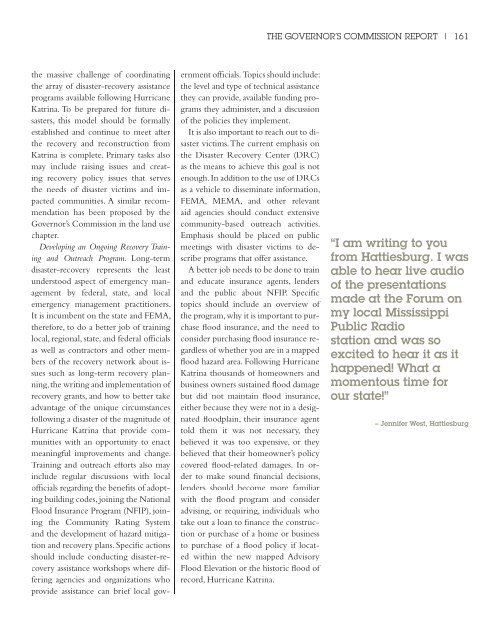Reports - Mississippi Renewal
Reports - Mississippi Renewal
Reports - Mississippi Renewal
- No tags were found...
You also want an ePaper? Increase the reach of your titles
YUMPU automatically turns print PDFs into web optimized ePapers that Google loves.
THE GOVERNOR’S COMMISSION REPORT | 161the massive challenge of coordinatingthe array of disaster-recovery assistanceprograms available following HurricaneKatrina. To be prepared for future disasters,this model should be formallyestablished and continue to meet afterthe recovery and reconstruction fromKatrina is complete. Primary tasks alsomay include raising issues and creatingrecovery policy issues that servesthe needs of disaster victims and impactedcommunities. A similar recommendationhas been proposed by theGovernor’s Commission in the land usechapter.Developing an Ongoing Recovery Trainingand Outreach Program. Long-termdisaster-recovery represents the leastunderstood aspect of emergency managementby federal, state, and localemergency management practitioners.It is incumbent on the state and FEMA,therefore, to do a better job of traininglocal, regional, state, and federal officialsas well as contractors and other membersof the recovery network about issuessuch as long-term recovery planning,the writing and implementation ofrecovery grants, and how to better takeadvantage of the unique circumstancesfollowing a disaster of the magnitude ofHurricane Katrina that provide communitieswith an opportunity to enactmeaningful improvements and change.Training and outreach efforts also mayinclude regular discussions with localofficials regarding the benefits of adoptingbuilding codes, joining the NationalFlood Insurance Program (NFIP), joiningthe Community Rating Systemand the development of hazard mitigationand recovery plans. Specific actionsshould include conducting disaster-recoveryassistance workshops where differingagencies and organizations whoprovide assistance can brief local governmentofficials. Topics should include:the level and type of technical assistancethey can provide, available funding programsthey administer, and a discussionof the policies they implement.It is also important to reach out to disastervictims. The current emphasis onthe Disaster Recovery Center (DRC)as the means to achieve this goal is notenough. In addition to the use of DRCsas a vehicle to disseminate information,FEMA, MEMA, and other relevantaid agencies should conduct extensivecommunity-based outreach activities.Emphasis should be placed on publicmeetings with disaster victims to describeprograms that offer assistance.A better job needs to be done to trainand educate insurance agents, lendersand the public about NFIP. Specifictopics should include an overview ofthe program, why it is important to purchaseflood insurance, and the need toconsider purchasing flood insurance regardlessof whether you are in a mappedflood hazard area. Following HurricaneKatrina thousands of homeowners andbusiness owners sustained flood damagebut did not maintain flood insurance,either because they were not in a designatedfloodplain, their insurance agenttold them it was not necessary, theybelieved it was too expensive, or theybelieved that their homeowner’s policycovered flood-related damages. In orderto make sound financial decisions,lenders should become more familiarwith the flood program and consideradvising, or requiring, individuals whotake out a loan to finance the constructionor purchase of a home or businessto purchase of a flood policy if locatedwithin the new mapped AdvisoryFlood Elevation or the historic flood ofrecord, Hurricane Katrina.“I am writing to youfrom Hattiesburg. I wasable to hear live audioof the presentationsmade at the Forum onmy local <strong>Mississippi</strong>Public Radiostation and was soexcited to hear it as ithappened! What amomentous time forour state!”– Jennifer West, Hattiesburg




